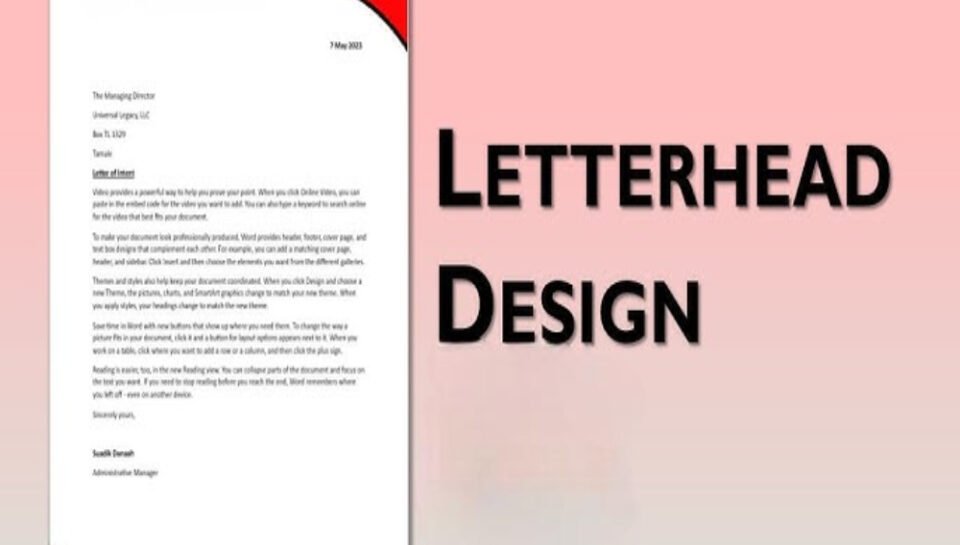
Detail the considerations for designing letterheads for different departments.
INTRODUCTION
Designing letterheads for different departments within an organization is more than a matter of aesthetics—it’s a strategic approach to enhancing communication clarity, reinforcing brand consistency, and establishing functional differentiation. Each department has unique communication needs, and their letterhead must reflect both their role and the organization’s overarching identity. When designed thoughtfully, departmental letterheads maintain uniformity while supporting specific operational and messaging requirements.
1. MAINTAIN CORE BRAND ELEMENTS
Every department’s letterhead must consistently reflect the company’s brand. This includes standardized use of the logo, brand colors, typography, and legal identifiers. These elements ensure that all communications—whether from HR or finance—feel like they come from the same organization.
2. CUSTOMIZE HEADINGS TO DEPARTMENT NAMES
To differentiate departments, include the department name below the logo or above the content area. For example, “Human Resources Division” or “Marketing Department” clearly identifies the source of the communication while maintaining professionalism.
3. USE COLOR VARIATIONS FOR FUNCTIONALITY
Subtle color variations—such as colored lines, section headers, or background accents—can help distinguish between departments. A consistent template using distinct accent colors for each department supports visual organization without breaking brand guidelines.
4. ADAPT CONTACT DETAILS PER DEPARTMENT
Each department may have unique phone numbers, emails, or office locations. Ensure the footer or header includes accurate and department-specific contact information, while keeping layout uniform across templates.
5. TAILOR CONTENT SPACE TO COMMUNICATION TYPE
Design layouts based on each department’s typical document structure. Legal or finance may require more space for disclaimers or figures, while marketing may benefit from white space for emphasis or visual hierarchy.
6. REFLECT TONE AND FUNCTION THROUGH DESIGN
Departmental letterhead should subtly reflect the tone of the department’s work. For example:
- Legal and Compliance: Conservative, minimalistic design
- Creative/Marketing: Slightly more expressive within brand limits
- Technical/IT: Modern, clean layout with room for data references
7. INCLUDE ROLE-SPECIFIC SECURITY OR CONFIDENTIALITY MARKERS
Departments like HR or legal may need built-in text like “Confidential” or space for document classification. These elements should be integrated into the design without disrupting readability or aesthetics.
8. DESIGN FOR INTERNAL AND EXTERNAL USE CASES
Some departments, such as operations or procurement, issue documents internally, while others like sales or public relations often communicate externally. Templates should be optimized based on the document’s typical audience and purpose.
9. SUPPORT MULTI-FORMAT USABILITY
Ensure departmental letterheads are functional across various formats—print, PDF, or Word templates. Maintain responsive layouts that remain consistent whether used in digital memos, official letters, or formal notices.
10. ENABLE EASY TEMPLATE ACCESS AND VERSION CONTROL
To ensure proper use, departmental letterhead templates should be stored in a central repository with access control. Maintain version consistency and update templates as branding or contact information evolves.
CONCLUSION
Designing letterheads for different departments requires a balance between uniformity and customization. While the core brand identity must remain intact, each department’s communication needs should shape the design to ensure relevance, functionality, and clarity. A well-executed departmental letterhead system strengthens brand professionalism and streamlines internal and external correspondence.
HASHTAGS
#LetterheadDesign #DepartmentalBranding #CorporateCommunication #BusinessStationery #VisualIdentity #InternalBranding #BrandConsistency #DepartmentTemplates #FunctionalDesign #BrandAlignment #DesignCustomization #PrintDesign #DigitalStationery #WorkplaceCommunication #DesignStandards #LetterheadTips #ProfessionalDesign #DesignClarity #TemplateManagement #CorporateStationery #OfficeTemplates #DepartmentDesign #TypographyInDesign #BrandStrategy #OrganizationalDesign





